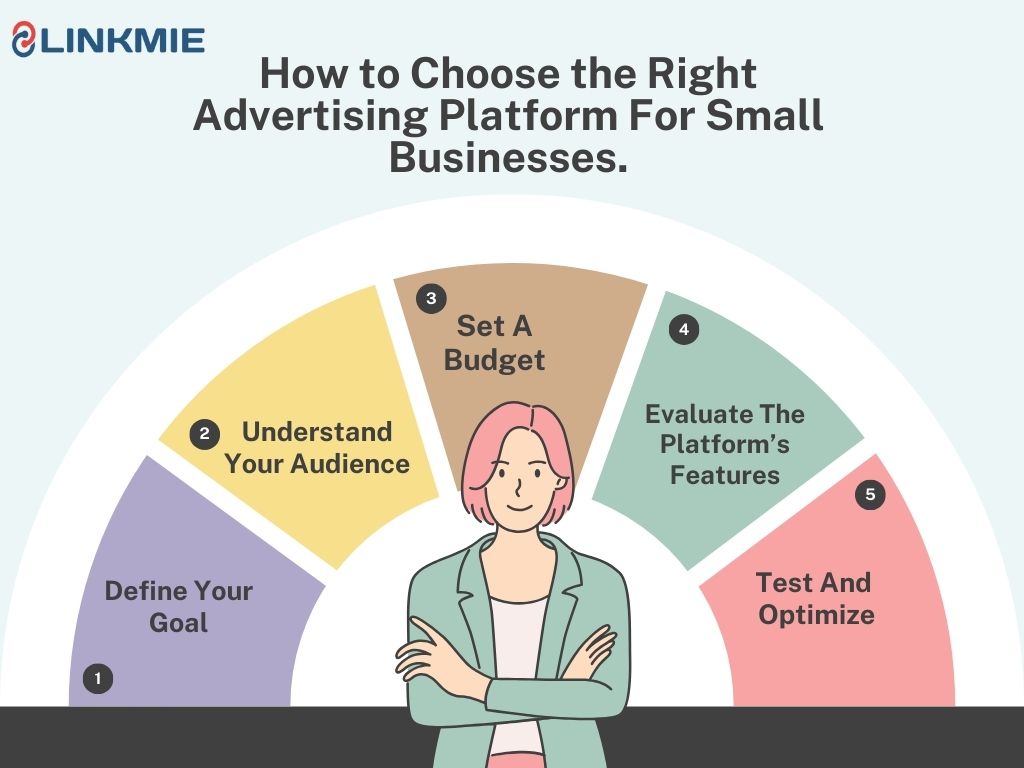It can be hard to find the Best Advertising Platforms for Small Businesses. There are so many choices, and it can feel like you’re always chasing the next best thing. With so many voices online, it’s easy to get lost and feel overwhelmed, especially when each decision feels like a big one. But on the contrary, you don’t need a huge budget or a big team to make a real impact. By choosing the best advertising platforms for small businesses, you can stand out, connect with your audience, and see your business grow.
This article breaks down what advertising platforms are, highlights some of the best advertising platforms for small businesses, and shares easy tips to help you make the most of your advertising budget.
What Are Advertising Platforms?
Advertising platforms are tools that help businesses show their products or services to the right people. They come with features like choosing who sees your ads, tracking results, and offering different ways to create ads. This makes it easier for businesses to connect with potential customers.
Some common types of advertising platforms are:
- Search engines (like Google Ads)
- Social media (like Facebook Ads and Instagram Ads)
- Online stores (like Amazon Ads)
- Content platforms (like Taboola and Outbrain)
- Streaming services (like YouTube Ads and Spotify Ads)
Top Advertising Platforms For Small Businesses in 2024.
#1. Google Ads:
Google Ads is great for businesses that want customers ready to take action. It lets you target specific keywords so your ads show up when people search for products or services like yours. With its pay-per-click (PPC) system, you only pay when someone clicks on your ad, making it budget-friendly. You can reach people through search, display, shopping, or YouTube ads, all while using smart tools to connect with the right audience.
#2. Facebook & Instagram Ads:
This is best for businesses wanting to tell a story or connect socially. Facebook and Instagram make it easy for businesses to advertise without spending too much. They let you target specific groups of people based on their interests, age, and habits. Small businesses can also use a mix of regular posts and paid ads to reach more people and get them interested.
#3. LinkedIn Ads:
This is best for companies focused on B2B or professional connections. LinkedIn is the top platform for business professionals. Small B2B businesses can use LinkedIn Ads to reach other businesses or professionals in their industry. You can run sponsored posts, send direct messages with InMail, or use simple text ads. These are great for finding new leads and building your brand’s reputation. It can be used to promote services, job openings, or content aimed at businesses.
#4. Amazon Ads:
Amazon Ads is best for online stores and brands selling products. They help you show your products to millions of shoppers, often when they’re ready to buy.
#5.TikTok Ads:
TikTok Ads is your go-to platform if your target audience is young people.
TikTok lets you create fun, short videos to engage users and jump on viral trends.
#6. Programmatic Advertising Platforms:
This is best for simplifying ad buying with automation.
Tools like The Trade Desk use AI to automatically buy ad spots, helping you make smarter, data-driven decisions.
#7. Pinterest Ads:
This is best for small e-commerce and lifestyle businesses. Pinterest is like a visual search engine, making it perfect for creative industries like fashion, home décor, food, and beauty. With Pinterest Ads, you can target people based on what they like and what they do, helping to bring more visitors to your website or product pages.
#8. Google My Business (GMB):
This is mainly for small, local businesses. Google My Business is a free tool that helps your business show up in local searches on Google and Google Maps. By keeping your GMB profile updated and optimized, you can attract more visitors and get local customers without paying for ads. It’s especially useful for shops, service providers, and businesses with a physical location.
#9.Yelp Ads:
Local businesses. Yelp is perfect for businesses that count on nearby customers, like restaurants, shops, or service providers. Yelp Ads can help you show up higher in local searches and make it easier to get customer reviews, which are super important for attracting more people and improving your local SEO.
#10. Reddit Ads:
This platform is for small businesses targeting specific interest groups. Reddit is full of active communities (called subreddits) that focus on all kinds of topics. If your business aligns with a particular niche, you can use Reddit ads to reach people who are already interested in what you offer. This can drive traffic from a highly engaged audience that cares about your product or service.
How to Choose the Right Advertising Platform For Small Businesses.

#1. Define Your Goal:
Choosing the right advertising platform starts by knowing what you want to achieve. Clear goals help you make smart choices and get the most out of your budget.
If you want to build brand awareness, platforms with a wide reach, like Facebook, Instagram, or YouTube, are great for introducing your brand to new people.
To drive website traffic, Google Ads works well by targeting people who are already looking for products or services like yours.
For lead generation or sales, LinkedIn (for B2B) and Instagram (for products that rely on visuals) have features like lead forms and shoppable posts to help you get more conversions.
Setting your goals first is like using a GPS—it keeps your strategy on track and helps you stay focused.
#2. Understand Your Audience:
Understanding your target audience is crucial when picking the right advertising platform. Different platforms attract different people, so knowing your ideal customers helps you choose where they’re most likely to be.
For example, younger audiences might be more active on TikTok or Instagram, while LinkedIn works better for professionals. Visual products do well on sites like Pinterest and Instagram. By understanding your audience’s habits and interests, you can create more focused ads, making your campaign more successful. Instead of advertising everywhere, be smart about where and how you promote your product.
#3. Set A Budget:
Setting a budget for your advertising campaign helps you spend wisely and get a good return on your investment. First, figure out how much you’re willing to spend, keeping in mind the platform, the size of your campaign, and how long it will run. If you’re just starting, it’s a good idea to begin with a small budget and test things out before increasing it.
Break your budget down based on how the platform charges (like pay-per-click for Google Ads or cost-per-impression for Facebook) to get an idea of how far your budget will go and how long your campaign can run. Set daily or total budgets to keep your costs in check while allowing some flexibility.
Make sure to regularly check how your ads are performing and adjust your budget. Focus more on the ads that are working well, and pause the ones that aren’t bringing in results, so you get the most value from your budget.
#4. Evaluate The Platform’s Features:
When choosing an advertising platform, think about its targeting options, ad formats, and analytics. Good targeting helps your ads get to the right people based on things like where they live, what they’re interested in, or their behaviour.
Different ad formats, like videos or carousel ads, can help you meet your campaign goals. Analytics are key for tracking how well your ads are doing, including clicks, engagement, and conversions, so you can improve your strategy. In the end, pick a platform with the right features to reach your audience, share your message, and track your results.
#5.Test And Optimize:
Testing and improving your ads is key to making them work better and save money. In the beginning, it’s hard to know what will grab your audience’s attention, so it’s helpful to try different types of ads, target different groups, and use different messages. By reviewing the test results, you can stop ads that aren’t working and focus on the ones that are doing well. This process, known as A/B testing, helps you avoid wasting money and makes your ads more effective, giving you better results over time.
To help you keep track of how well your ads are doing, we’ve created an easy-to-use Ad Performance Tracker. This tool shows important details like how many people saw your ads, how many clicked on them, how many took action, and how much each result cost. With this tracker, you can make smart decisions, spot patterns, and improve your campaigns to get better results.
Conclusion
Small businesses have many advertising platforms to choose from, each serving different purposes and audiences. To pick the right one, it’s important to match the platform’s features with your goals, like building brand awareness, getting more website visitors, or finding new customers. Knowing who your audience is and how they spend time online helps create campaigns that really work. With a clear budget and a plan to test and improve as you go, businesses can use these platforms to see real results and grow their brand in a competitive world.
Frequently Asked Questions.
What are advertising platforms?
Advertising platforms are tools that help businesses show their products or services to the right people. They provide features like choosing who to target, creating ads, and tracking how well the ads perform, making it easier for businesses to reach potential customers.
Which advertising platform is best for small businesses?
The best advertising platform for small businesses depends on what you’re trying to achieve. Google Ads, Facebook and Instagram Ads, LinkedIn Ads, and TikTok Ads are all good options, but the right one for you will depend on who you’re trying to reach and your business goals.
How do Google Ads work for small businesses?
Google Ads helps small businesses show their ads to people searching for specific products or services. It works on a pay-per-click (PPC) basis, meaning you only pay when someone clicks on your ad. This makes it a cost-effective option.
What’s the advantage of using Facebook & Instagram Ads?
Facebook and Instagram Ads are great for businesses that want to connect with people on social media. You can target users based on their interests, age, location, and activities. These ads are effective for telling your brand story and engaging with potential customers.
Why should small businesses use LinkedIn Ads?
LinkedIn Ads are ideal for businesses that focus on professional relationships or B2B (business-to-business) marketing. They offer different ad types like sponsored posts, InMail, and text ads, helping businesses reach leads and strengthen their brand within a professional network.






